Flour power: Meet the chef, bakers, millers and farmers seeking to save wheat's bad name
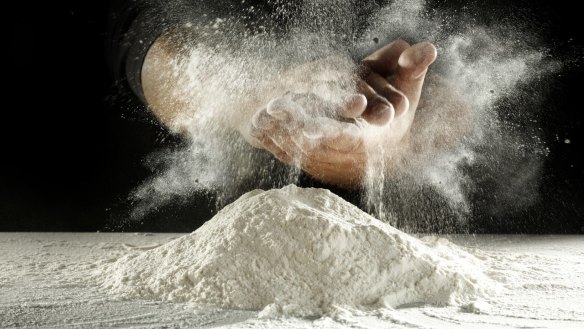
Afraid of 'grain brain'. Worried about 'wheat belly'. Going gluten-free. If you aren't, you know someone who is. So what went wrong with wheat? This nutritious grass, farmed for its grain for almost 10,000 years, has underpinned western civilisation since Neolithic times. Societies flourished, fought, crumbled and rebuilt - and wheat was there too, fuelling human activity, a humble yet essential staple.
But in recent decades, wheat has lost its mojo, especially in rich and industrialised countries like Australia. Farmers are disconnected from consumers, producing wheat as a commodity crop traded on world markets with little regard for its eventual consumption. Flour is heavily refined and turned into mass production fast-risen bread. Along the way, more and more people have found wheat hard to digest: bread-avoiders abound and health commentators decry wheat as bad for bellies and brains, a pesticide-laden, genetically altered burden on the body. An honourable and nourishing cereal is now viewed by many as a suspicious source of evil carbohydrates and troublesome gluten.
But bread is not dead. From farm to mill, bakery to table, passionate loaf-lovers are rising up to bring us our daily bread and to ensure it is healthy, nourishing, digestible and delicious. It's a flour-dusted revolution, says top chef Dan Hunter, who has just harvested his first wheat crop at award-winning Brae. "Gluten-intolerance and anti-wheat sentiment have become mainstream and now we see the building of a subculture, almost an underground, that is working to change it," he says. "Real bread – and flour – is coming back."
The chef
Dan Hunter, chef and owner of Brae in western Victoria, has recently harvested his first wheat crop, organically grown in a paddock in front of his award-winning restaurant. "We got five tonnes from three hectares, a great result for our first year," he says.
He's always loved bread and pastries – "I'm an average Australian male, I've always lived on carbs". But he's also on the frontline of wheat avoidance, with an increasing number of his diners steering clear. Hunter believes pesticide use is the main cause many people no longer tolerate wheat. "The epidemic of gluten intolerance is most likely due to toxic wheat having a negative impact on our biology," he says. Beyond being chemical-free, Hunter thinks flour tastes nicer when it's carefully milled from organically grown wheat and used fresh.
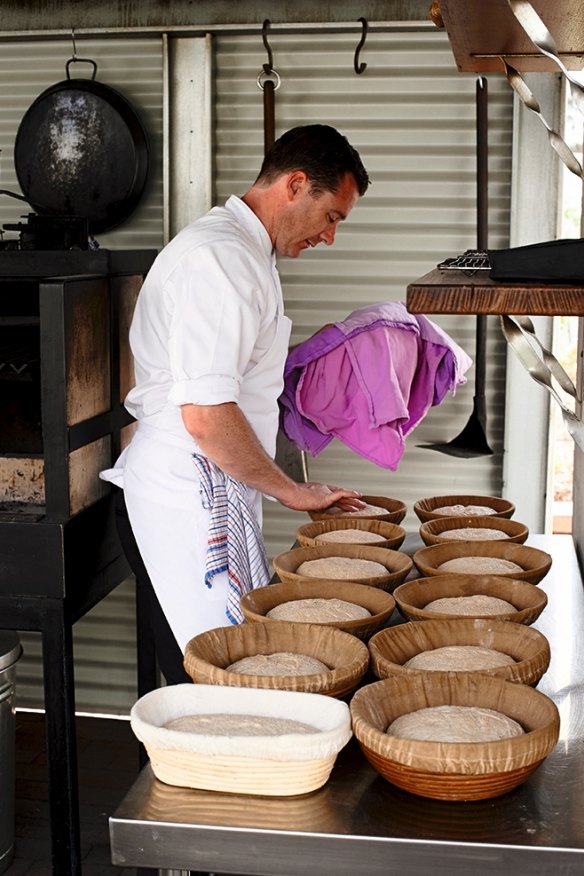
"This is a restaurant," he says. "I work in the game of flavour and pleasure. Flour hasn't been used like an ingredient. It's just been this bag of dead starch sitting in the corner of the kitchen. Do we really want to eat that stuff?" Working with vibrant, locally grown ingredients aligns with Hunter's ethics and is more exciting as a cook. "We just made a wholewheat croissant: it's so delicious, so intense, with caramelised flavours and the true taste of the grain."
Hunter sees those looking at wheat in new ways as an important movement in modern agriculture. "Many farmers are looking at new perspectives and how they can grow sustainably and healthily. They are looking at different wheats, and wheats of origin, much like we think about chardonnay or coffee. Wheat is not wheat is not wheat: that's what we're starting to understand."
The farmer
"Wheat seems to have lost its good name," says Jason Cotter from Tuerong Farm, on the Mornington Peninsula south-east of Melbourne. "There's been a pop culture shift away from wheat for supposed health reasons and it seems ridiculous. It's long been a key food source for humans." Cotter thinks that modern farming has driven a wedge between people and their food. "We started chasing yield at the expense of quality and industrial farming turned grain from a foodstuff into a simple commodity," he says. Cotter thinks it's important that grain is grown sustainably, milled carefully and fermented properly before it's eaten. "Our idea is to reclaim wheat as a food with flavour and nutrition." he says.
He's turned part of his family's cattle and grape holding into a small-scale wheat farm, where he's growing a mixture of modern and heritage wheat varieties, with a focus on great-tasting flour. "We're growing four types of French red wheat, three types of Australian hard white wheat, plus khorasan, spelt and emmer, which are what people call ancient grains," he says. He's also testing over 100 varieties of heritage wheat from the 19th and early 20th centuries. "It's a hobby that's got out of hand," he says.
Inspired by on-farm chef Dan Barber's book The Third Plate, Cotter is developing a local grain economy. He mills on site and sells to local food stores, bakers and chefs. "Wheat stopped being a local food," he says. "I'd love to see more decentralisation with smaller farms and mills providing single-origin flour that's an expression of the wheat variety and their region."
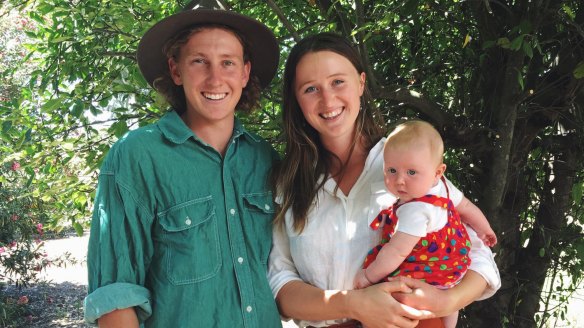
The small-scale miller
Courtney Young and her husband Ian Congdon run Woodstock Flour in New South Wales' Southern Riverina. They sell stoneground, wholegrain flour milled from organic wheat grown on the property by Ian's parents. "We think of flour as a plant product, an amazing plant that has provided sustenance and been a massive part of our culture for thousands of years," she says. "We approach it in a similar way to coffee or wine. We celebrate grains for their flavour rather than look at them as a blank canvas or a simple source of energy."
It doesn't surprise Young that flour has a diminished reputation. "Every layer of the system has been bastardised. Most wheat is grown in high-input intensive systems with a reliance on herbicides or pesticides and the soil it's grown in isn't looked after. The wheat is milled with rollers that turn it into highly refined white flour, which means the bran and germ on the grain kernel is stripped off and it has no nutritional value. It's shelf-stable but it's lifeless."
Woodstock recently bought a granite mill to turn its wheat into wholegrain flour. That's good – but tricky. "It's full of flavour and nutritional value but it's not shelf stable; the oils in the germ go rancid over time," Young explains. She recommends that people use their flour within three months and they deliver to bakeries fortnightly – "the fresher the better". The delivery schedule has the added benefit of connecting with consumers. "It's great to know where your grain ends up and see people enjoy the product," she says. "It's given us a greater sense of meaning and accountability."
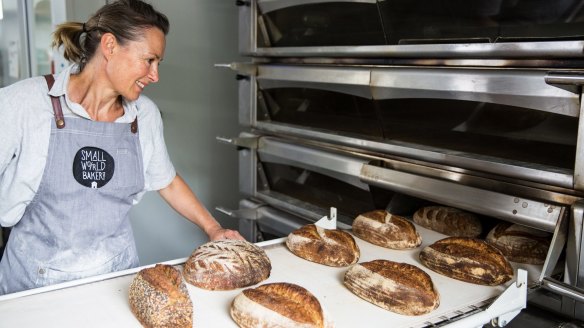
The grain activist
Emily Salkeld had been running sourdough Small World Bakery south-east of Adelaide for six years before she really started thinking about flour. "Like most bakers, we thought about flour in terms of function, the way it performs in bread," she says. "When we thought about flavour, we were really thinking about the flavour of fermentation not the base product."
Four years ago, she was at Tivoli Road Bakery in Melbourne. "They had a small benchtop stonemill to add freshly milled flour to their bread," she recalls. "I tasted the loaf. There was a creaminess, flavours to do with the field, the grain itself, not the fermentation. It stimulated my inner baking nerd." She and her husband Chris Duffy closed their bakery for a year and dove deep into wheat, travelling to Europe and the USA, talking, learning, eating.
By understanding the trajectory of modern wheat, they worked out how they wanted to change tack. In the middle of the 20th century, technology and market forces drove farmers to grow wheat for yield and disease resistance rather than flavour. "Modern wheat was bred to grow more quickly so it could be harvested before disease had a chance to develop," she says. "We want to show there's an alternative."
Now they grow their own grain on leased plots, as well as buying grain from selected local farmers, before stonemilling the wheat to use in their bread. One of the most rewarding aspects has been the connection to growers. She was in one of her plots recently and asked her neighbour farmer how she would know when the grain was ready to harvest. "He pulled up one of our wheat plants, chewed on the stem, then said, 'It's still sweet which means the plant is active and the grain is still developing.' He was so gratified to tell me that. Farmers are astounded that a baker is speaking to them about what's in their paddock – no one has done that for 30 years."
Salkeld has been a bread nerd for ages. Now she's a wheat nerd too. "Wheats come in different colours: blue, purple, dark brown, light brown, light red, dark red," she says. "I love a red wheat called Marquis. I love the dark red colour in the bran and the bread made from it is so delicious with a malty tea character I really like."
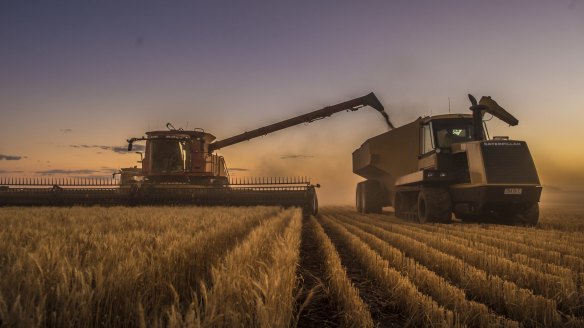
The industrial miller
Mark Laucke is the fifth-generation owner of Laucke, which has a large mill in Bridgewater on Loddon, 200 kilometres north-west of Melbourne, and another in South Australia. He's something of an elder statesmen in the world of flour and advises many of the industry's artisan up-and-comers. He believes that much of the current anti-grain rhetoric (basically, humans aren't supposed to eat it) is unscientific nonsense.
But he believes bread dough should be properly fermented and that fermented foods are essential to good health. He says the problems people have eating bread these days can in large part be traced to fast-risen commercial bread that makes the human digestive system work too hard. "I truly and firmly believe that traditional fermentation is the fundamental thing that enables human societies around the world to exist, remain and develop," he says. Good bread uses good flour, fermented with a sourdough starter.
He is also a proponent of wholegrain flour, but not in the sense of milling all parts of the grain as one, because different parts of the grain respond better to different types of milling. His $20 million Victorian facility uses a complex system of roller mills and sieves to separate parcels of wheat into their various components and then recombine them to create purpose-made shelf-stable flours, mostly for commercial bakeries. "People think doing things at scale is bad but it's not," he says. "We take dozens of flour streams, each subtly different, and we bring them together. It's a blend like Penfolds would use for Grange."
His aim is to deliver the best possible flour with the most potential for good flavour and health, but ensuring a happy gut outcome lies largely in the fermentation that happens prior to baking.
The baker

James Partington runs Staple Bread & Necessities on Sydney's northern beaches. The sourdough bakery has only been open a year but it launched with a bang, winning the gold medal for best sourdough and the overall prize for best bread at Sydney's 2018 Royal Easter Show. Partington uses a stoneground flour from Wholegrain Milling, a large family-owned mill in Gunnedah, New South Wales.
He's a proponent of great-tasting fresh flour that becomes brilliant bread after slow fermentation. "Bread is a vehicle for nutrition, so we should use the best possible ingredients and treat them right," he says. "People don't know what flour tastes like any more. It's sad. Fresh flour has grassy undertones, it smells like it's alive and it's going to do you some good. Flour on the supermarket shelf is benign, it smells of wallpaper paste."
His customers tell him that his bread not only tastes good but is easy to digest. "In many cases, people who struggle with wheat are eating crap bread that's been under-fermented," he says. "It creates bloating. I have many customers that are so grateful for my bread. They can eat it with comfort."
WHEAT AND HEALTH
The topic of wheat and health is a minefield littered with strong opinion and selective plucking of science. There's no doubt that some people react badly to some wheat, though the causes are debated. However, wheat's nutritional value is clear. It is a good source of energy, dietary fibre, protein, B vitamins and iron, especially when eaten as a whole grain. When wheat is used to make long-fermented bread risen with natural sourdough cultures, it's thought to assist in gut health too.
RECONNECT TO FLOUR
■ Buy a loaf of award-winning sourdough and book in for a sourdough class at Staple Bread and Necessities, 20-28 Montauban Avenue, Seaforth, NSW
■ Make a pancake. Staple's James Partington suggests the best way to reconnect to the idea of flour as a flavourful ingredient is to buy an interesting flour and make a pancake with it. "Do something basic and easy so you can taste the flour," he says.
■ Buy Tuerong Farm flour at stockists including Meatsmith.
■ Purchase Laucke's Wallaby flour blend from selected supermarkets and eat bread made with their flour at Infinity Sourdough (Darlinghurst, Paddington and Manly, New South Wales) and Woodfrog (St Kilda, Camberwell and Kew, plus other locations, Victoria), among many others.
■ Go to GrAiNZ, an annual gathering around the new grain economy. It's October 7-9 at Red Beard Bakery in Trentham, Victoria. Follow @_grainz_ for updates.
INDIGENOUS GRAINS
Australia's indigenous grains – not wheat – probably made the world's first ever bread. Grindstones dating back around 36,000 years suggest that Aboriginal Australians were the world's first bakers, around 19,000 years ahead of the Egyptians, who are often given that title. Efforts are under way to restore Indigenous Australian baking by growing and harvesting kangaroo grass and native millet.
